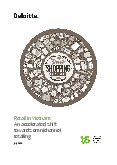








Preview text:
SCHOOL OF PSO MBA ASSIGNMENT COVER SHEET STUDENT DETAILS Student name: PHAN VAN CUONG Student ID number: 23005355
UNIT AND TUTORIAL DETAILS Unit name:
Strategic Marketing Management Unit number: Tutorial group: Tutorial day and time: Lecturer or Tutor name: Dr. Thuong Phat Tang ASSIGNMENT DETAILS Title:
Individual Assignment - A Customer Journey Map (MBA Talk)/Customer Insight Length: Due date: 18/06/2023 Date submitted: 18/06/2023
Home campus (where you are enrolled): ISB – 17 Pham Ngoc Thach DECLARATION
I hold a copy of this assignment if the original is lost or damaged. X
I hereby certify that no part of this assignment or product has been copied from any other student’s work or from
X any other source except where due acknowledgement is made in the assignment.
I hereby certify that no part of this assignment or product has been submitted by me in another (previous or X
current) assessment, except where appropriately referenced, and with prior permission from the Lecturer /
Tutor / Unit Coordinator for this unit.
No part of the assignment/product has been written/produced for me by any other person except where
X collaboration has been authorised by the Lecturer / Tutor /Unit Coordinator concerned.
I am aware that this work will be reproduced and submitted to plagiarism detection software programs for the
X purpose of detecting possible plagiarism (which may retain a copy on its database for future plagiarism checking). Student’s signature: PHAN VAN CUONG
Note: An examiner or lecturer / tutor has the right to not mark this assignment if the above declaration has not been signed.
A Customer Journey Map
The following is a recent guest contribution to MBA Talk by Mr. Kiet Phan, who serves as the Head of Omni Channel at PNJ.
The following insights were acquired through the aforementioned discourse:
A customer journey map is a visual representation that documents the complete journey a customer
undertakes towards a specific objective during the course of product usage. The journey is depicted in a
vivid visual manner that effectively conveys each action, emotion, thought, or motivation that the
customer experiences while utilizing the product. -
By utilizing the data and perspectives provided by the Customer Journey Map, the organization
can effectively guide its sales and marketing endeavors as well as product innovation, thereby
facilitating optimal customer satisfaction and attainment of their objectives.
In order to construct a customer journey map, it is imperative to initially comprehend the identity of the
individual who assumes the role of the "passenger" throughout said journey. The creation of a customer
is a fundamental step in the development of a customer journey map, which provides a detailed
representation of the intended audience for a product or service. Customer personas offer a
comprehensive and detailed representation of customers, encompassing their demographics, psychology,
behavior, motivation, and problems, based on survey results and data collected from current customers.
The customer journey is typically segmented into five distinct phases. The consumer decision journey
typically involves five stages: awareness, consideration, purchase, retention, and support (advocacy).
The key points I learned from the experience of the guests through this talk were:
Why does it matter in the context of multiple digital and
non-digital emerging business models?
o In the current era of Digital Marketing (DM), engaging with the Zero Moment of Truth (ZMOT) holds
significance in influencing the consumer's buying behavior. The utilization of this approach facilitates a
more frequent and efficient engagement with the touchpoint, thereby augmenting the proportion of
clientele availing the firm's product services and fostering enduring allegiance to the brand.
A highly applicable framework in different business context
o In the process of constructing a Customer Journey Map (CJM), it is not uncommon for the information
and experiences of the creator to be inaccurate. To mitigate this issue, it is recommended that the creator
of the CJM consult with individuals who regularly interact with customers, such as salespeople, customer
service representatives, and social media managers. By gathering and continuously updating information
from these sources, the creator can refine and improve the accuracy of the Customer Persona over time.
Subsequently, the model is exhibiting increased precision and efficacy.
o The precision of the customer profile plays a crucial role in facilitating product development,
enhancing sales, optimizing customer experience, mitigating the likelihood of incidents, forecasting
customer demand trends, and ultimately broadening the product portfolio.
What will shut down your plan and how to gear up for a contingency plan
o Various factors influence customer journey mapping (CJM), including the efficacy of marketing
strategies or plans, which must be tailored to the intended audience and satisfy the established criteria.
The key concepts under consideration are brand identity, customer loyalty, customer attention, and sales growth.
o However, as professionals in strategic planning, it is imperative that we require additional information
beyond that. It is imperative to establish contingencies in the event of a plan's failure and to proactively
devise alternative courses of action. The individual in the role of manager is typically responsible for
recognizing the potential of a given project, utilizing sound judgment to make informed decisions, and
identifying potential risks associated with the endeavor.
o It is crucial for the company to ensure that its personnel are instilled with the organization's ideology
and growth trajectory. While the efficacy of the plan may be subject to debate, it is imperative that the
fundamental principles and beliefs of the organization remain steadfast.
The outcome of the MBA day topic discussion
The fundamental principle of marketing is to prioritize the identification and fulfillment of
customers' specific needs. The tools facilitate efficient work processes, however, the fundamental
aspect remains attuned to the demands of the clientele.
● Marketing efforts ought to align with the fundamental principles and beliefs of the organization.
Efficient support tools have been developed to aid in adaptive research, which necessitates their optimal utilization. Customer Insight
Consumer insight is defined as the intimate, shared understanding of the spoken
and latent,current and future needs of target customers
Collecting and analyzing customer insights answers crucial questions like:
● What is the reason behind the decline in sales of a specific product?
● What is the probability of achieving success in a novel target market?
● What is the perception of your brand among your target audience?
● What are the strategies to enhance conversion rates?
● What are the perceptions and emotions of potential customers towards a given product?
● What are the strategies employed to upsell customers?
● What are the inventory requirements?
● What strategies can be employed to achieve a competitive advantage over rival firms?
Acquiring knowledge of customer insights facilitates the precise identification of customer
requirements and emerging trends. By addressing customer pain points through tailored
advertising and sales strategies, businesses can optimize profitability while minimizing resource utilization.
5 Steps to Customer Insight
I. Decision Making Unit Analysis
A decision-making unit (DMU) refers to a limited number of individuals who exert an impact on a
specific purchase or decision-making procedure.
By gaining an understanding of the user, buyer, payer, influencer, and final decider, it is possible to
identify the target audience for the product, determine the key decision makers, and recognize the
individuals who hold sway over the buyer's decision-making process.
Subsequently, it is feasible to formulate particular tactics aimed at directing resources towards the
prevention of resource and time wastage.
The determinants that impact the choices made by consumers when making a purchase, ranked in a
descending order, are as follows:
The interplay between culture, social class, and social references can significantly influence the
socialization and behavior of individuals within their immediate social circles.
The identification of the habits and needs of our target customers can facilitate the identification of the
factors that are significant to our behavior.Individuals frequently rely on emotions and feelings rather than
rationality when making decisions, often without conscious awareness.
II. Customer Need Analysis
At this stage, we will conduct an analysis of the present requirements of the target customer group. At
present, what is the current position of customers in Maslow's hierarchy of needs?
This section can be readily observed in the context of selling hamburgers, as customers typically seek
sustenance to satiate their hunger, a comfortable seating area to rest their feet, or a pleasant ambiance to
enhance their dining experience.
Upon conducting an analysis of the customer's requirements, it is possible to ascertain their purchasing
motivation, thereby facilitating the identification of the appropriate product. In addition to offering
alternatives for establishing a brand identity that aligns with customer requirements.
III. Buying Process Analysis
The purchasing process of a customer pertains to the series of stages that a customer undergoes
in arriving at a decision to purchase a product or service. The customer journey commences with
the identification of a need or desire and culminates with the attainment of satisfaction upon the
acquisition of a product or service.
Typically, the procedure comprises several phases, namely:
● Identification of a problem.
● The process of seeking out and obtaining information. ● Assessment of options.
● The act of making a decision to acquire a product or service.
● Evaluation conducted by consumers after making a purchase.
● The delineation of each stage is contingent upon the actions and decisions of the
customer, as well as a range of factors including personal needs, preferences, and external influences.
The purchasing process of customers is a fundamental concept in the field of marketing as it aids
businesses in comprehending the customer's perspective and devising efficacious strategies to
attract and convert them into customers.
IV. Customer Value Analysis
Customer value analysis (CVA) is one of the key jobs you must complete in order to stay ahead of your competition.
Customer value analysis (CVA) seeks to increase customer satisfaction in your company.
Continue reading to learn how the CVA can be used to: ● Value measurement
● Compare yourself to your competitors. ● Increase consumer loyalty
● Determine potential dangers to loyal customer connections.
There are two techniques or applications.
● Economic value added to customer (EVC): Estimate of objective value
● Multi-attribute modeling (MAM): Composition of subjective value
V. Usage and Consumption Analysis
By this step, we need to understand well enough to be able to answer the following questions, which will
help us figure out how much is being used and how happy customers are.
● What are the typical usage patterns of the product, including the timing and manner of usage?
● What are the prevalent issues encountered in the utilization of a product?
● Do customers utilize the product in a manner that deviates from the initially projected usage?
● Are customers experiencing additional benefits beyond their anticipated outcomes?
● Do consumers exhibit a tendency to customize the product to suit their individual needs and preferences?
A rock-solid customer insights strategy helps you make better choices about how to improve your product
and where it's going, as well as how to meet users' changing needs.
Understanding your customers and what parts of your product or service really work and why should be
at the center of your plan for making better and new products that meet real-world needs. And with a tech
stack that includes customer data and product experience (PX) insights, you can be sure that all your
insights are up-to-date and in one place, so you can easily share them with your team and make quick choices that drive growth.




